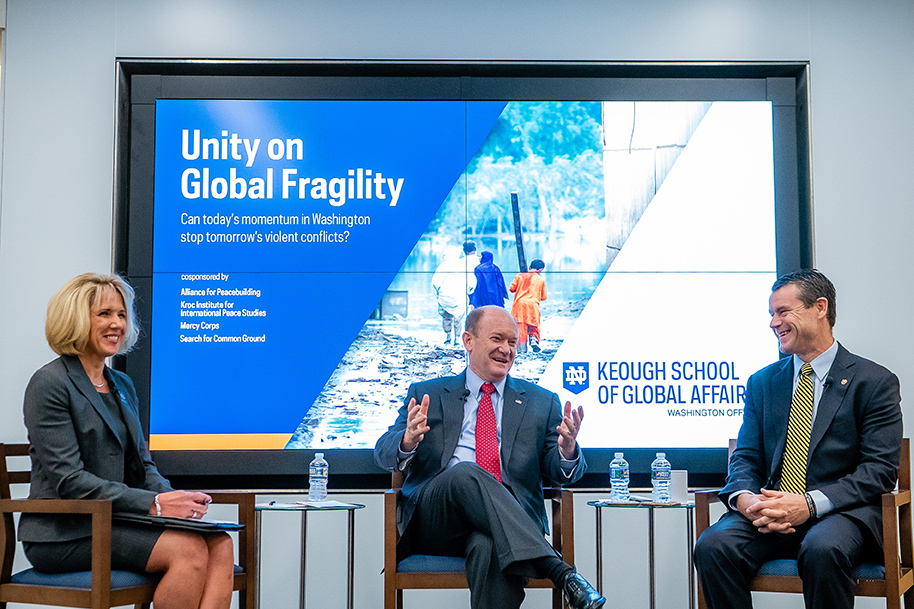Americans are disheartened and divided. Deep cynicism regarding our democracy is widespread and threatens both political parties. A mere twenty percent of Americans trust Washington to “do the right thing,” and only one quarter say the tone of political discourse is respectful. In addition to not trusting national leaders, Americans disagree with each other on many issues, including foreign policy. For example, the Chicago Council on Global Affairs found that the top five international threats identified by Democrats do not match any of the top five identified by Republicans.
The presidential campaigns mirror this foreign policy divide, presenting a stark contrast regarding how the United States should engage in the world. As a result, nationalism versus internationalism is one of the many contentious issues in the battle for the White House.
We value human dignity not only through our relationships with each other as individuals, but also as actors within a community of nations.
It has not always been this way. When our leaders have found common ground, America has enjoyed critical national security and foreign policy achievements: containing Communism, expanding NATO, and fighting HIV/AIDs and the Ebola virus, to name a few. These successes exemplify the United States acting in its national security interests, while also acting as a full participant in the global community and valuing the dignity of others.
As the principles of integral human development articulate, we value human dignity not only through our relationships with each other as individuals, but also as actors within a community of nations. Despite the polarization in America, the United States has a new opportunity to be this kind of global actor again.
The Global Fragility Act
Recently, Washington has found areas of cooperation and agreement on international priorities. One example is a new US strategy to respond to the needs of “fragile states.” The bipartisan Global Fragility Act (GFA) became law at the end of 2019 as part of the 2020 Consolidated Appropriations Act (see section on GFA here). It codifies a game-changing approach to preventing and reducing violent conflict in areas of the world considered most fragile, based on data from sources such as the Fragile States Index and the Early Warning Project.
The law mandates a ten-year US strategy to tackle root causes of instability in countries and regions that are home to victims of injustices such as widespread corruption, violent conflict, food insecurity, institutionalized persecution, and extreme impacts of climate change.
The Global Fragility Act is an example of a functioning democracy—proof that bipartisan negotiation and compromise exist on Capitol Hill.
In the Global Fragility Act, Congress directs the executive branch, specifically the Departments of State and Defense and the Agency for International Development (USAID), to establish a preventative and whole-of-government approach to achieving long-term global stability. It authorizes $1.15 billion over the next five years towards implementation.
Finding common ground on prevention
The Global Fragility Act is inspiring, even revolutionary, in its promotion of peacebuilding. It positions the United States to be an active proponent of human dignity through the law’s support for locally driven solutions to the drivers of fragility.
Disaffected Americans may be encouraged to know the GFA is also an example of a functioning democracy—proof that bipartisan negotiation and compromise exist on Capitol Hill and laws can accommodate various policy interests.
In the House of Representatives, the leading Republican on the Foreign Affairs Committee, Texas representative Michael McCaul, joined the committee’s Democratic chairman, New York representative Elliot Engel, in championing the GFA. They shepherded it victoriously through their committee and final passage on the House floor.
The legislative success story of the Global Fragility Act also features the contributions of evidence-based research.
In the Senate, Democratic senator Chris Coons of Delaware co-authored the bill with South Carolina Republican senator Lindsey Graham and worked tirelessly to get it across the finish line. Senators Jeff Merkley (D-OR), Marco Rubio (R-FL) and Todd Young (R-IN) were co-sponsors. The public statements of these senators upon introduction of the GFA emphasized different aspects of the law.
Whether focused on “combatting extremism and terrorism” or the moral obligation of the US to be a world leader in “alleviating human suffering,” they found common ground on the wisdom of prevention. In July, 2019, Senator Todd Young participated in a Washington, DC, global fragility forum organized by the Keough School where he explained this shared viewpoint: “We cannot afford not to invest in prevention . . . You end up paying so much more on the back end, so we need to be a lot more intelligent and responsible stewards of [public funds].”
At that same event, Senator Coons expressed the shared determination of these senators to push for passage of the GFA, which at that time was at a standstill. “[This] means months of close-in work with . . . senators who frankly vote against anything that expands foreign aid,” he said. Such conviction helped transform the GFA from legislation into law and is essential moving forward to ensure it is implemented effectively.
Evidence-based policymaking
The legislative success story of the GFA also features the contributions of evidence-based research. Without it, sponsors of the legislation would have had a hard time garnering votes. For example, the fact that official development assistance (ODA) from the US government to “fragile” countries increased by 26 percent between 2009 and 2016 supported the cost-effectiveness argument. In addition, when the GFA was making its way through Congress, the Institute for Economics and Peace released its Global Peace Index 2019 that estimated the cost of containing violence to be at $14.1 trillion a year globally, equivalent to 11.2 percent of the world’s gross domestic product.
The 2018 report of the bipartisan Task Force on Extremism in Fragile States led by the United States Institute of Peace, as well as the World Bank and United Nations’ “Pathways for Peace” helped lay the groundwork for the GFA. The task force examined the findings of the 9/11 Commission Report, analyzed subsequent US policies to combat terrorism, and compiled comparative and longitudinal data on various policy interventions. The task force outlined a framework for strategic prevention aimed at establishing, “a coherent, coordinated, and committed focus to prevent the underlying causes of extremism in fragile states.”
Americans should find reassurance knowing that evidence-based and humane policy is moving forward.
Also in 2018, the Department of State, Department of Defense and USAID jointly published the Stabilization Assistance Review, which provided a roadmap for interagency coordination on conflict prevention. Finding that more than one-third of US foreign assistance in the previous decade had gone to countries experiencing violent conflict, they jointly recommended locally driven solutions to create stability.
The SAR’s groundbreaking and comprehensive analysis drew lessons from past US engagement in eight conflict-affected areas including Afghanistan and Iraq, where the government has had lengthy operations involving significant failures. Indeed, many argue that violent extremism has been a symptom of these failures. Specifically, the instability that followed the US intervention in Iraq created conditions conducive to the rise of the Islamic State of Iraq and the Levant (ISIL).
Credible advocacy
Beyond excellent research to bolster the case for interagency conflict prevention investments, advocacy for the GFA was credible and effective. The Alliance for Peacebuilding and Mercy Corps led a coalition of more than seventy nonpartisan peacebuilding, humanitarian and development organizations that participated actively in drafting the GFA and advocating for its passage for over two years.
These organizations, and many others, have been actively engaged in its implementation through well-researched reports such as Mercy Corps’ Implementing the Global Fragility Act: From Policy to Strategy and Alliance for Peacebuilding and One Earth Future Foundation’s Getting from Here to There: Successful Implementation of the Global Fragility Act. Best practices for monitoring and evaluation of US policies and programs in conflict environments include the Center for Global Development’s Creating an Accountability Framework that Serves the Global Fragility Act’s Mission and the Keough School’s Strategic Monitoring in Fragile States.
Like all credible advocates, supporters of GFA and its mission have also been holding the government’s feet to the fire. The Center for Strategic and International Studies raised concerns that the government was already failing to uphold the SAR’s stabilization principles for political and regional planning and engagement. Last month, the GFA coalition criticized the US government for not meeting the statutory deadline to submit a comprehensive Global Fragility Strategy to Congress.
These respected policy experts, and many others, will keep pressure on Congress to appropriate the funds authorized by the GFA. Their voices remain critical in order for the legislation to fulfill its promises of stabilizing fragile countries, while also protecting US national security interests and saving taxpayer dollars.
Policy in Action
The Global Fragility Act is ambitious, requiring major reshaping of foreign aid, diplomacy and national security operations. For it to succeed and create real change in the lives of the world’s most vulnerable people, it needs a strong start.
Experienced government officials are moving it forward steadily, navigating bureaucratic silos, intra-agency tensions, and uncertainty as the election looms. The day to day work of these civil servants, both in Washington and stationed across the globe, occurs far beneath the noise of American politics, but that is where policy turns into action.
In September, the State Department submitted a report to Congress outlining the interagency approach to GFA implementation, and later this month it is expected to release the comprehensive Global Fragility Strategy, establishing a framework for interagency efforts in selected countries and regions over the next ten years.
Together, these documents will create the foundation of the law’s implementation over the next ten years. They must be solid in order to ensure the GFA can withstand shifting political winds, changes of committee leadership, and transitions between Administrations. The work is far from over.
Conclusion
During this time of political polarization and paralysis, Americans should find reassurance knowing evidence-based and humane policy focused on the dire needs of the world is moving forward. That despite different foreign policy priorities, members of Congress can find common ground and respond to the suffering of our brothers and sisters. Implementation of the GFA remains in its early stages, but may one day prove that, in fact, there is a chance for human dignity in Washington.
Maura Policelli is executive director of the Keough School’s Washington Office.
This article is part of a series of blog posts published by the Keough School of Global Affairs. Dignity and Development provides in-depth analysis of global challenges through the lens of integral human development.



